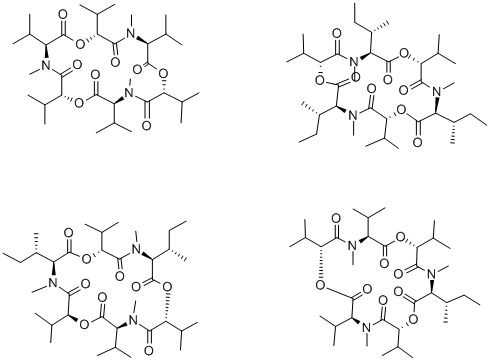Uses
Enniatin complex is a complex mixture of Fusarium produced depsipeptide ionophores.This compound can be used to control contamination in fermentation of gaseous substrates.
Uses
Enniatins are a complex of depsipeptides produced by several Fusarium species. Typically, the complex contains 4 major components: A, A1, B and B1 together with minor amounts of enniatins C, D, E and F. The enniatins act as ionophores. Recently their effects on acyl-CoA cholesterol transferase, as nematocides and the selectivity of their antitumour action have received more focus.
Biological Activity
enniatins, analogues of beauvericin, is a regular cyclic hexadepsipeptide isolated from fusarium species of fungis, also they have been isolated from other genera, such as verticillium and halosarpheia [1]. they have been involved in many biological activities, such as antiinsectan, antifungal, antibiotic and cytotoxic [1].
in vitro
fusafungine is a mixture of several enniatins with bacteriostatic activity against most micro-organisms responsible for infections and superinfections of the respiratory tract. fusafungine has been developed for treatment of upper respiratory tract infections by oral and/or nasal inhalation. fusafungine in low concentrations down-regulated the expression of intercellular adhesion molecule-1 (icam-1) by activated macrophages, inhibited the production of the proinflammatory cytokines il-1, tnfα and il-6 and inhibited the release of oxygen free radicals by inflammatory macrophages without altering their phagocytic activity. fusafungine also inhibited t-cell activation and proliferation, and the synthesis of ifn-γ by activated t cells [2]. exposure 8 h to enniatins at nanomolar concentrations significantly stimulated cell proliferation. at low micromolar concentrations, enniatins exihibited profound apoptosis-inducing effects against various human cancer cell types. in the fluorescence-activated cell sorting analysis, enniatins induced cell cycle arrest in the g0/g1 phase. in human cancer cells, elevated enn concentrations induced profound p53-dependent cytostatic and p53-independent cytotoxic activities [3]. enniatin easily incorporated into the cell membrane in which it formed cation-selective pores [4].
Purification Methods
It is a cyclic peptidic ester antibiotic which is recrystallised from EtOH/water but is deactivated in alkaline solution. [Ovchinnikov & Ivanov in The Proteins (Neurath and Hill eds) Academic Press, NY, Vol V pp. 365 and 516 1982, Tomeda et al. J Antibiot 45 1626 1992.]
References
[1] sy-cordero a a, pearce c j, oberlies n h. revisiting the enniatins: a review of their isolation, biosynthesis, structure determination and biological activities[j]. the journal of antibiotics, 2012, 65(11): 541-549.
[2] german-fattal m. fusafungine, an antimicrobial with anti-inflammatory properties in respiratory tract infections[j]. clinical drug investigation, 2001, 21(9): 653-670.
[3] dornetshuber r, heffeter p, kamyar m r, et al. enniatin exerts p53-dependent cytostatic and p53-independent cytotoxic activities against human cancer cells[j]. chemical research in toxicology, 2007, 20(3): 465-473.
[4] kamyar m, rawnduzi p, studenik c r, et al. investigation of the electrophysiological properties of enniatins[j]. archives of biochemistry and biophysics, 2004, 429(2): 215-223.


